Analysis of the Efficiency of Slope Evacuation for Dense Crowds in Urban Street-Type Public Spaces
Abstract
:1. Introduction
2. Related Works
2.1. Study on Street-Type Public Space
2.2. Simulation Study of Pedestrian Flow on Slopes
2.3. Pedestrian Movement in Groups
3. Risk Analysis of Crowd Gathering on Slope in Urban Street Spaces
3.1. Risk Analysis of Slope Evacuation
3.2. Mechanism of Slope Stampede Formation in Street-Type Public Space
- (1)
- Pre-accident period: During the holidays, the number of tourists to be received at major tourist attractions multiplies, causing a large number of people to spontaneously converge in the street-type field. The narrow spatial characteristics of the street space tend to lead to poor visibility for pedestrians and chaotic conflicts with multi-directional pedestrian flows [17]. Adverse weather conditions, such as rain and fog, can have a significant impact on pedestrian behavior. Pedestrians’ perception of safety is disturbed by weather factors. For example, in low visibility conditions, pedestrians’ cognitive abilities may be affected since the capabilities of visual and auditory cognitions of the environment are reduced [26]. Poor light quality, especially in the evening or in poorly lit areas, further impairs pedestrians’ ability to assess the safety of their surroundings and avoid collisions [27]. Additionally, the presence of obstacles or temporary facilities blocking pedestrian paths exacerbates congestion by creating bottlenecks [28]. The density of the crowd in this stage is relatively low, and the crowd is still able to move freely, but the number and density of the crowd are on the rise.
- (2)
- Accident evolutionary period: As the density of the crowd increases, the movement of the crowd is progressively restricted, especially under the compounding effects of poor weather or lighting conditions. When the flow of people gradually reaches the capacity limit of the space, the phenomenon of stagnation and congestion occurs. When the flow of people in the field exceeds the critical value, irrational competition for space and time triggers pushing and shoving [29,30]. The presence of obstacles exacerbates the creation of bottleneck areas, while the panic caused by the rapid spread of rumors further accelerates the deterioration of the situation [31].
- (3)
- Consequences of the accident: Stampede accidents cause serious casualties and damage to public facilities. Poor lighting conditions can make evacuation difficult, impede rescue operations, and increase the psychological stress for trapped people. Excessive psychological stress on the crowd may lead to mass riots or disturbances, with lasting effects on the individuals and communities involved. With the rapid intervention of evacuation, rescue, pacification, investigation, and public opinion response, the incident gradually subsided and the authorities began to identify the cause and restore order, allowing the incident to enter the final phase.
3.3. Analysis of Factors Affecting Pedestrian Movement Speed
3.3.1. Effect of Crowd Density on the Speed of Pedestrian Movement
3.3.2. Effect of Slope on the Speed of Pedestrian Movement
3.3.3. Effect of Environmental Factors on the Speed of Pedestrian Movement
4. Evacuation Scenario Setup
4.1. Software Introduction
4.2. Physical Model
4.3. Evacuee Parameters
4.4. Evacuation Scenarios
4.4.1. Range of Slope
4.4.2. Range of Street Width
4.4.3. Obstacle Layout Pattern
4.4.4. Type and Percentage of Disability
4.4.5. Group Movement
5. Results
5.1. Effect of Slope on Evacuation Time
- (1)
- In terms of personal factors, on nearly horizontal ramps with a slope of less than 4°, pedestrians’ speed of movement increases to some extent due to the effect of gravity during the descent. However, on gently inclined ramps with a slope of more than 4°, pedestrians will reduce their speed to maintain their stability to prevent falling due to the increased perception of the slope by the human body itself;
- (2)
- In terms of group factors, at a steeper 8° slope, especially in emergencies, evacuating crowds tend to step faster unconsciously and are more motivated to evacuate. Crowds tend to be closer to each other when evacuating, and the phenomenon of pedestrians pushing each other will be strengthened, which requires pedestrians to exert more physical strength and attention to maintain their balance. To a certain extent, this will increase the risk of stampede accidents.
- (1)
- There is a linear positive correlation between the average evacuation time at different slopes and the crowd density as the crowd density increases.
- (2)
- As the crowd density increases, the degree of influence of slope on evacuation time grows in parallel. When the crowd density is in the range of 0.50–1.00 pedestrians/m2, the curve grows more gently, the degree of influence of the slope on the evacuation time is weak; when the crowd density is greater than 1.00 pedestrians/m2, the curve begins to steepen, the degree of influence of the slope on the evacuation time is enhanced.
5.2. Effect of Street Width on Evacuation Times
- (1)
- Physiologically, when the width of the slope reaches a certain level, the pedestrian movement speed stabilizes at its limit value, and the flow rate of the evacuation channel reaches saturation. This phenomenon is consistent with the typical flow rate model: , where is flow rate, is density, and is speed. At a certain crowd density, when pedestrian speeds reach their limit values, further increasing the street width does not significantly increase the flow rate, so the change in evacuation time stabilizes.
- (2)
- Psychologically, in a wider evacuation channel, the overall crowd density and congestion decrease. Pedestrians will feel more relaxed without a sense of urgency. The effect of crowd flow may be influenced by other factors, such as the composition of the crowd, the direction of walking, the interaction between the crowd, and environmental factors.
5.3. Effect of Obstacle Layout on Evacuation Time
- (1)
- When the number of obstacles is the same, the number of stranded people with obstacles distributed on both sides of the street (e.g., Layout 4) is almost twice that of the centered layout (e.g., Layout 6), which suggests that pedestrians had to change the direction of their movement frequently to avoid these obstacles when the obstacles were located on both sides of the street, leading to an increase in evacuation time. On the contrary, if the obstacles are located in the middle of the street, pedestrians can travel more directly along straighter paths, reducing the frequency of direction changes, thus shortening evacuation time and reducing the risk of being stranded.
- (2)
- The number of people stranded in Layout 3 is slightly lower than the number of people stranded in Layout 4 when the obstacles are distributed on both sides of the street. This phenomenon indicates that in Layout 3, the symmetrically distributed barriers on both sides provide similar and regular walking routes for pedestrians during evacuation. Pedestrians can plan their routes in a relatively orderly manner, reducing mutual interference and congestion. However, in Layout 4, due to the asymmetrical distribution of obstacles, the evacuation routes for pedestrians become complicated and irregular. Pedestrians may get confused due to sudden changes in the routes when avoiding obstacles, leading to increased local congestion.
- (3)
- Although the obstacles in both Layout 5 and Layout 6 are centrally arranged, only Layout 6 produces the phenomenon of stranded people. This is because in Layout 5, pedestrians can move forward relatively straight along the vertically aligned obstacles, and the presence of the obstacles instead serves to divert the crowd so that the flow of people can be smooth and continuous. In contrast, in Layout 6, the side-by-side placement of barriers exacerbates the fluctuating changes in evacuation route widths and adversely affects the stability of pedestrian flow, highlighting the importance of carefully considering the location of barriers when designing evacuation routes and public spaces.
- (4)
- Layout 7 resulted in the highest number of stranded pedestrians due to the highest number of obstacles and the most complex layout, which severely restricted the movement of pedestrians, disrupted the flow of people, and made it difficult for pedestrians to find suitable evacuation routes, and the negative impacts of such a situation should be circumvented as far as possible.
5.4. Effect of Disability Type on Evacuation Time
- (1)
- The most significant impact on evacuation efficiency is felt by people with mobility impairments (wheelchair users), the slope of the fitted curve for wheelchair users is 5.07915, which is the largest among the four types. Wheelchair users are dependent on assistive devices, move slower, and require more space or additional help in evacuation, reducing the capacity of the aisles and increasing the complexity of evacuation. In addition, wheelchair users are at greater risk on sloped streets, where loss of control can lead to serious falls and injuries.
- (2)
- Visually impaired people have the second highest impact on evacuation efficiency, the slope of the fitted curve for visually impaired people is 2.62776. These people are highly dependent on the environment, have difficulty in recognizing directions, cannot see signs or exit directions, are prone to making mistakes or staying in the same place, and need to rely on other people’s guidance or on auxiliary facilities (e.g., blind corridors) to complete evacuation.
- (3)
- Pedestrians using canes and hearing-impaired pedestrians had a relatively minor impact on evacuation times. The slopes of the fitted curve for these two types of disabled people are 1.09939 and 1.10182, respectively. Although the results of the study showed that the evacuation time of hearing-impaired pedestrians was lower than that of pedestrians using canes, the slope of the fitted curve for hearing-impaired pedestrians was slightly higher. This phenomenon is explained by the fact that hearing-impaired pedestrians have an information reception barrier and cannot hear critical evacuation information, such as sirens or voice announcements. As the percentage of hearing-impaired pedestrians in a crowd increases, the problem of miscommunication will become more pronounced, which will make coordinated evacuation more difficult. Pedestrians using canes, although limited in their mobility, have a greater advantage in accessing information and, therefore, have a relatively lower rate of increase in evacuation time.
5.5. Effect of Group Movement on Evacuation Time
- (1)
- The results show that the color gradient in each row is subtle as the slope increases from 1° to 15°. This suggests that the evacuation times for different group combinations change very little as the slope increases. In contrast, the color differences were more pronounced when comparing the colors of different group types. Thus, under congested conditions, the effect of pedestrian group movement on evacuation time is significantly greater than the effect of slope.
- (2)
- There are substantial color differences across different group types. For group types with a single age composition like “M-M-M” or “J-J-J”, the colors are more homogeneous within the row. This is largely dependent on the relatively consistent pedestrian evacuation ability within the single age group. In multi-age mixed group types, such as “M-J-J” or “O-M-J”, the colors show more variation within the row. This implies that evacuation efficiency varies with crowd size and age composition, the implications of which are highlighted below.
5.5.1. Effect of Group Size on Evacuation Time
5.5.2. Effect of Different Age Compositions on Evacuation Times
6. Discussion
7. Conclusions
- (1)
- From the perspective of spatial design, the slope of the street-type space should not be more than 4°, which can maintain the continuity of the flow of people while avoiding the congestion and stagnation caused by excessive slope.
- (2)
- From the perspective of site management, when the width of the evacuation channel is less than 2 m, it is more likely to cause congestion of dense crowds, which falls into the high-risk zone. Relevant management units should increase the deployment of security forces and enhance police dispatch to deal with emergencies.
- (3)
- In order to optimize pedestrian evacuation, it is necessary to reasonably plan the setup and layout of obstacles when designing public space, to improve the pedestrian’s access efficiency and comfort, and to ensure the smoothness of the evacuation channel.
- (4)
- From the perspective of crowd control, the age of evacuees and the variability of their evacuation ability should be taken into account to formulate an emergency evacuation plan to maximize the overall evacuation efficiency through reasonable control and guidance.
8. Limitations and Future Work
Author Contributions
Funding
Institutional Review Board Statement
Informed Consent Statement
Data Availability Statement
Conflicts of Interest
References
- People’s Political Consultative Conference Network. Available online: https://www.rmzxw.com.cn/c/2024-07-05/3574431.shtml (accessed on 5 July 2024).
- Ren, C.X.; Wu, Z.Z.; Liu, M. Analysis of Accident due to Swarm and Jostlement at Urban Public Place. J. China Saf. Sci. J. 2005, 15, 102–106. [Google Scholar]
- South Korean Police Release Results of Investigation into Itaewon Stampede in Seoul. Available online: http://korea.people.com.cn/n1/2023/0116/c407864-32607320.html (accessed on 16 January 2023).
- Lombard Street. Available online: https://baike.baidu.com/item/%E4%BC%A6%E5%B7%B4%E5%BA%95%E8%A1%97/13017754 (accessed on 12 March 2025).
- The Encyclopedia of Road Network in Hong Kong. Available online: https://hkroad.fandom.com/wiki/%E5%9D%A1%E9%81%93 (accessed on 13 March 2025).
- Lee, R.S.; Hughes, R.L. Exploring trampling and crushing in a crowd. J. Transp. Eng. 2005, 131, 575–582. [Google Scholar]
- Zhang, Q.S.; Liu, J.L.; Zhao, G.M. Discussion on cause mechanism of crowd crushing and trampling accident in large-scale public places. J. Nat. Disasters 2009, 18, 81–86. [Google Scholar]
- Niu, L.; Guan, H. The mechanism of crowd stampede based on case statistics through SNA method. J. Teh. Vjesn. 2021, 28, 548–555. [Google Scholar]
- Feliciani, C.; Nishinari, K. Measurement of congestion and intrinsic risk in pedestrian crowds. J. Transp. Res. Part C 2018, 91, 124–155. [Google Scholar]
- Song, S.Y.; Xu, K.; Shang, D.; Zhang, B.; Liang, T.R. Risk Analysis of Stampede Accidents in Crowded Places Based on Haddon Matrix and ISM. J. Saf. Environ. Eng. 2019, 26, 150–155. [Google Scholar]
- Liu, T.T.; Zhen, L.; Chai, Y.J.; Liu, C.J.; Chen, J.X. Method for crowd trampling and crushing simulation based on psychological model. J. Syst. Simul. 2020, 28, 2448–2454. [Google Scholar]
- Liu, Q.; Cao, Q.G.; Mi, X. Qualitative simulation of stampede accidents riskin large crowd gathering activities. J. Xi’an Univ. Sci. Technol. 2022, 42, 468–475. [Google Scholar]
- Yang, Y.; Yu, J.; Wang, C.; Wen, J. Risk Assessment of Crowd-Gathering in Urban Open Public Spaces Supported by Spatio-Temporal Big Data. J. Sustain. 2022, 14, 6175. [Google Scholar]
- Kafetzakis, I.; Konstantinou, I.; Mandalidis, D. Effects of Hiking-Dependent Walking Speeds and Slopes on Spatiotemporal Gait Parameters and Ground Reaction Forces: A Treadmill-Based Analysis in Healthy Young Adults. J. Appl. Sci. 2024, 14, 4383. [Google Scholar]
- Hoogendoorn, S.P.; Van Wageningen-Kessels, F.L.; Daamen, W.; Duives, D.C. Continuum modelling of pedestrian flows: From microscopic principles to self-organised macroscopic phenomena. J. Phys. A Stat. Mech. Appl. 2014, 416, 684–694. [Google Scholar] [CrossRef]
- Zuo, J.; Shi, J.; Li, C.; Mu, T.; Zeng, Y.; Dong, J. Simulation and optimization of pedestrian evacuation in high-density urban areas for effectiveness improvement. J. Environ. Impact Assess. Rev. 2021, 87, 106521. [Google Scholar] [CrossRef]
- Liu, X.F.; Lin, T.; Yu, Q.; Cao, X. Quantitative simulation of pedestrian evacuation and collision risk in urban street space. J. China Saf. Sci. 2023, 33, 133–141. [Google Scholar]
- Tang, X.F.; Ji, J.W.; Xie, X.L.; Wang, L.J. The experimental studies on influence of slope on evacuation. J. Fire Sci. Technol. 2017, 36, 1508–1511. [Google Scholar]
- Jian, X.X.; Zhang, X.N. Study on safety evacuation behavior for counter flow on an inclined tunnel. J. Syst. Eng. Theory Pract. 2017, 37, 2715–2726. [Google Scholar]
- Hu, Z.A.; Wei, Y.D.; Zeng, T.; Ma, Y. A social force model considering falls and injuries of pedestrian counterflow on slopes. J. Southwest Jiaotong Univ. 2023, 58, 1100–1109. [Google Scholar]
- Hu, Z.; Wang, S.; Wei, Y.; Du, J.; Zeng, T. Influence of slope angle and headway on the stepping behavior of single-file pedestrians: An experimental and modeling study. J. Phys. A Stat. Mech. Appl. 2025, 130488. [Google Scholar] [CrossRef]
- Moussaïd, M.; Perozo, N.; Garnier, S.; Helbing, D.; Theraulaz, G. The walking behaviour of pedestrian social groups and its impact on crowd dynamics. PLoS ONE 2010, 5, e10047. [Google Scholar]
- Zaki, M.H.; Sayed, T. Automated analysis of pedestrian group behavior in urban settings. J. IEEE Trans. Intell. Transp. Syst. 2017, 19, 1880–1889. [Google Scholar]
- Templeton, A.; Drury, J.; Philippides, A. Placing large group relations into pedestrian dynamics: Psychological crowds in counterflow. J. Collect. Dyn. 2020, 4, 1–22. [Google Scholar] [CrossRef]
- Hu, Y.; Ren, X.; Zhang, J.; Song, W. An experimental study on the movement characteristics of a social group in unidirectional flow. J. Transp. A Transp. Sci. 2023, 19, 2017066. [Google Scholar] [CrossRef]
- Zhu, M.; Graham, D.J.; Zhang, N.; Wang, Z.; Sze, N.N. Influences of weather on pedestrian safety perception at mid-block crossing: A CAVE-based study. J. Accid. Anal. Prev. 2025, 215, 107988. [Google Scholar] [CrossRef] [PubMed]
- Li, H.; He, S.M.; Kong, J. Vulnerability analysis of dense crowd stampede incident at night tour in scenic spots. J. Saf. Sci. Technol. 2022, 18, 56–63. [Google Scholar]
- Chen, J.; Luo, Q.; Wang, Q.; Lo, J.T.; Ma, J. Experimental study on individual and crowd movement features around obstacles with different shape and size. J. Phys. A Stat. Mech. Appl. 2024, 645, 129797. [Google Scholar] [CrossRef]
- Chen, N. Research on Smart Emergency Management of Stampede Incidents in Megacities—A Case Study of the Itaewon Stampede in Seoul. J. China Emerg. Manag. 2022, 7, 87–97. [Google Scholar]
- Yue, S.Y. Analysis on Stampede Accidents of Large-scale Spontaneous Congregation. J. City Disaster Reduct. 2023, 17–21. [Google Scholar] [CrossRef]
- Lügering, H.; Sieben, A. A Rumor has Spread like Wildfire?-Empirical Investigation of Information Propagation in Waiting Crowds. J. Collect. Dyn. 2024, 9, 1–28. [Google Scholar]
- Pathfinder Technical Reference Manual; Thunderhead: Manhattan, KS, USA, 2021; pp. 17–20.
- Sarmady, S.; Haron, F.; Talib, A.Z. Simulation of pedestrian movements on slope using fine grid cellular automata. arXiv 2020, arXiv:2010.03387. [Google Scholar]
- Cui, Y.; Wang, H.; You, B.; Cheng, C.; Li, M. Simulation Study on Fire Product Movement Law and Evacuation in a University High-Rise Teaching Building. Appl. Sci. 2023, 13, 10532. [Google Scholar] [CrossRef]
- Wang, L. Evacuation behavior and simulation of large public places based on PATHFINDER. J. Xi’an Univ. Sci. Technol. 2017, 37, 358–364. [Google Scholar]
- Hashemi, M. Emergency evacuation of people with disabilities: A survey of drills, simulations, and accessibility. J. Cogent Eng. 2018, 5, 1506304. [Google Scholar]
- TD/T 1055-2019; Technical Regulation of the Third Nationwide Land and Resources Survey. Ministry of Natural Resources: Beijing, China, 2019.


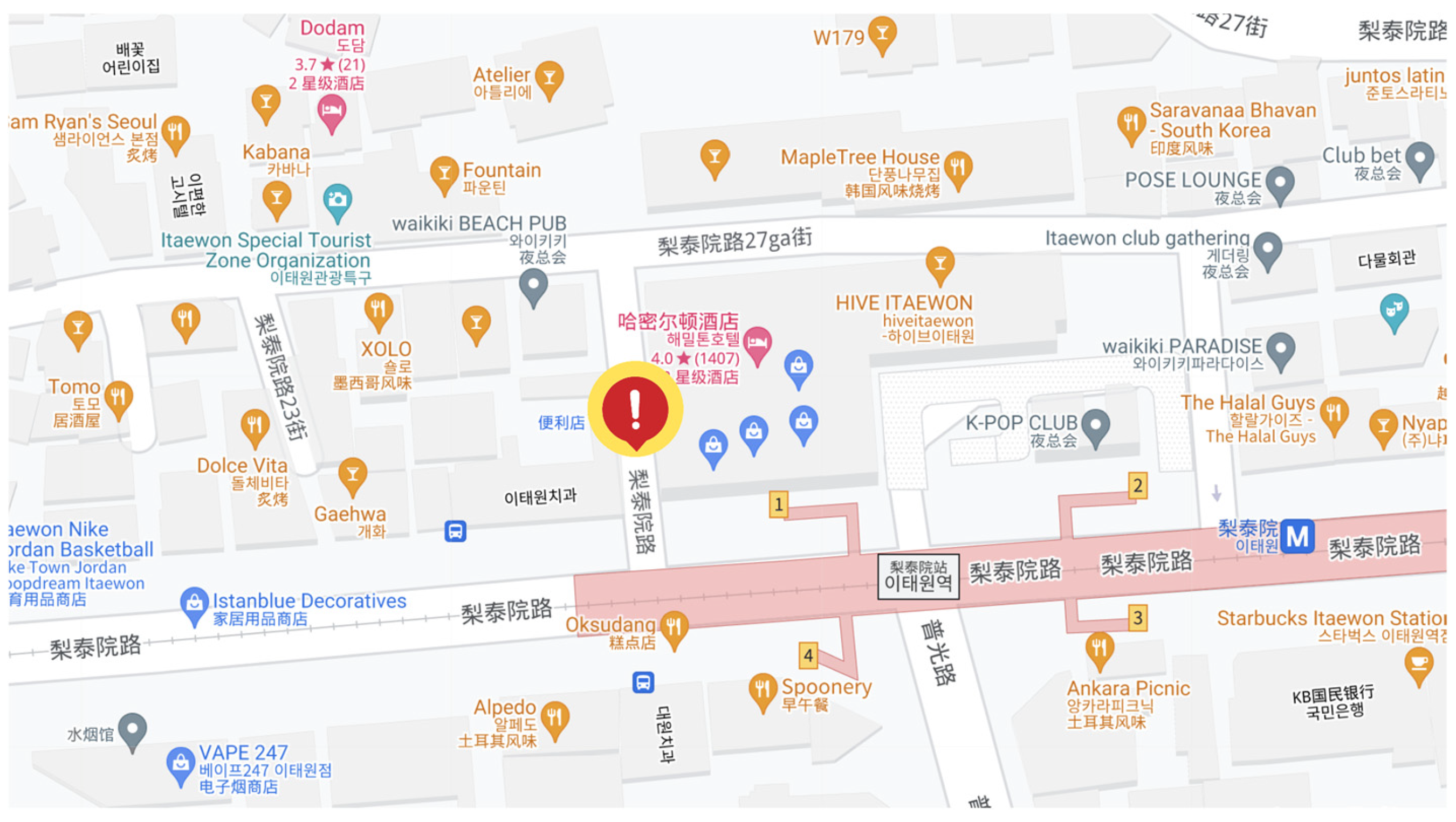
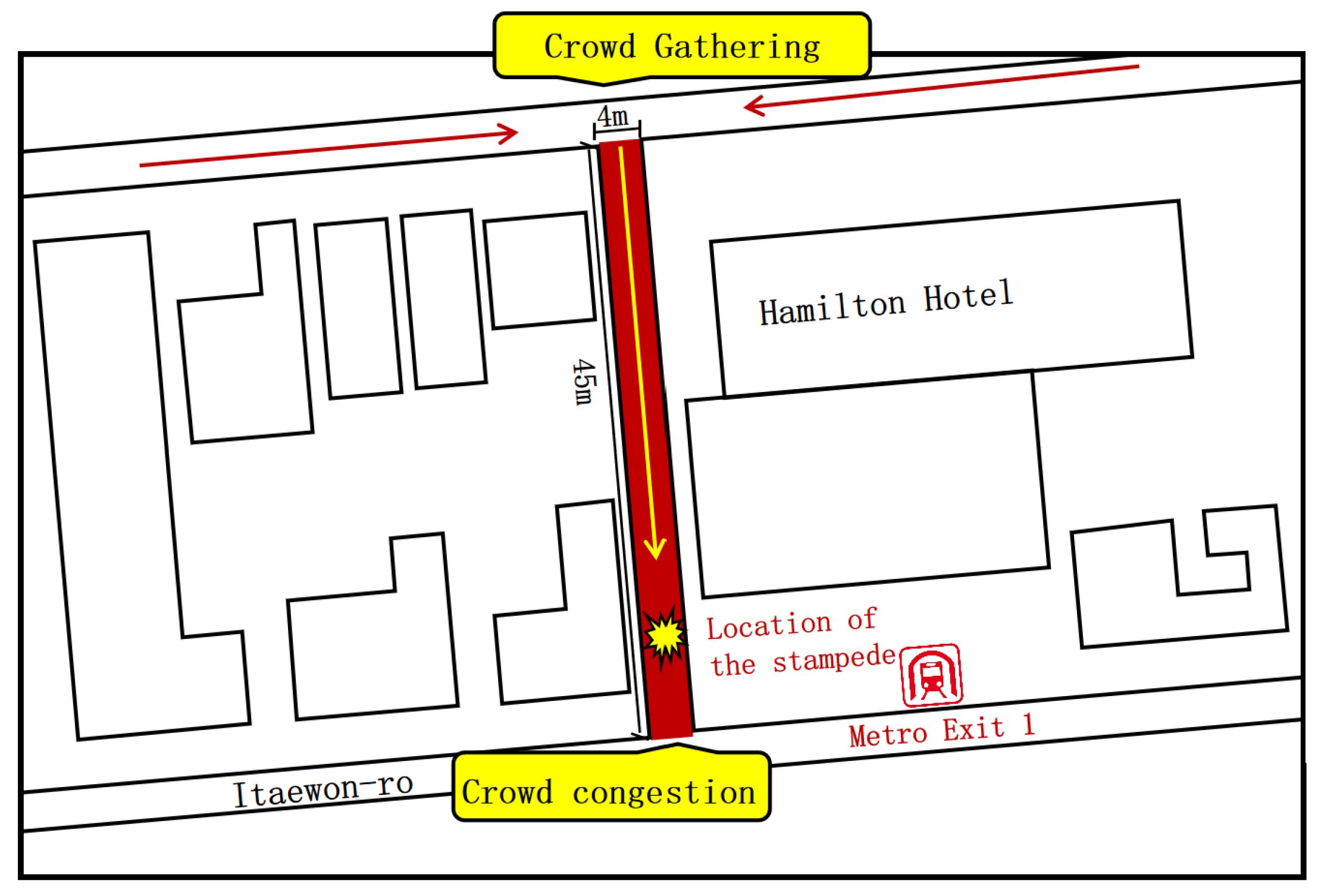
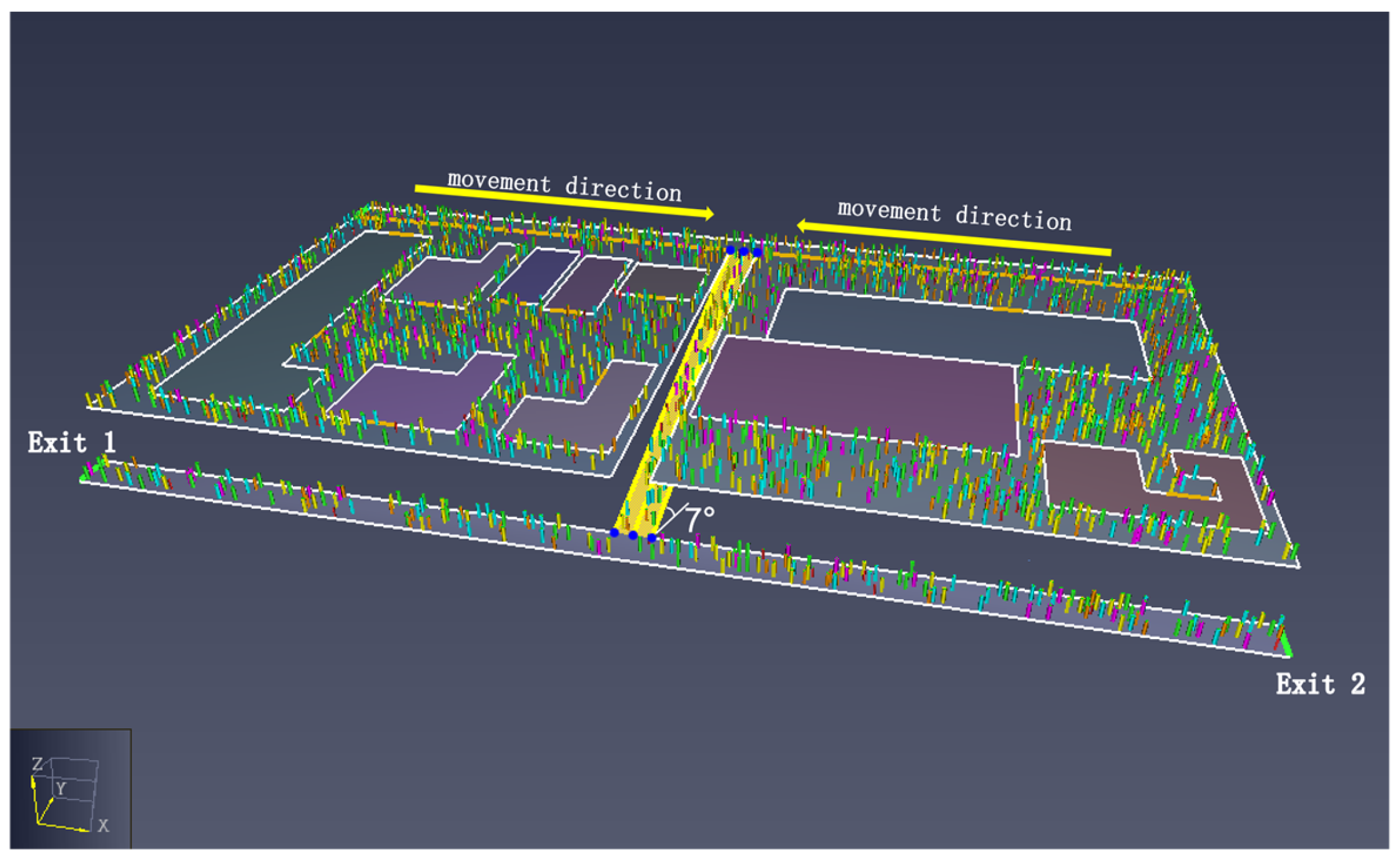

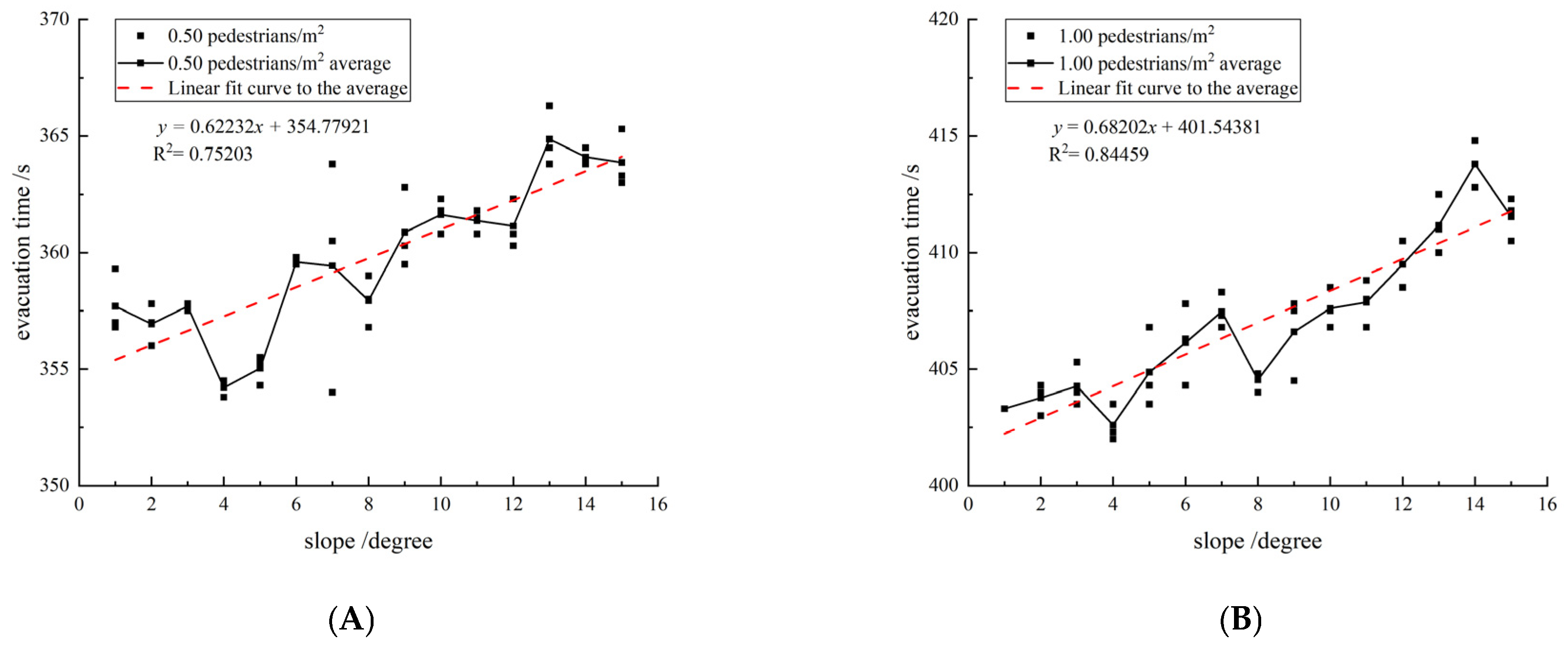

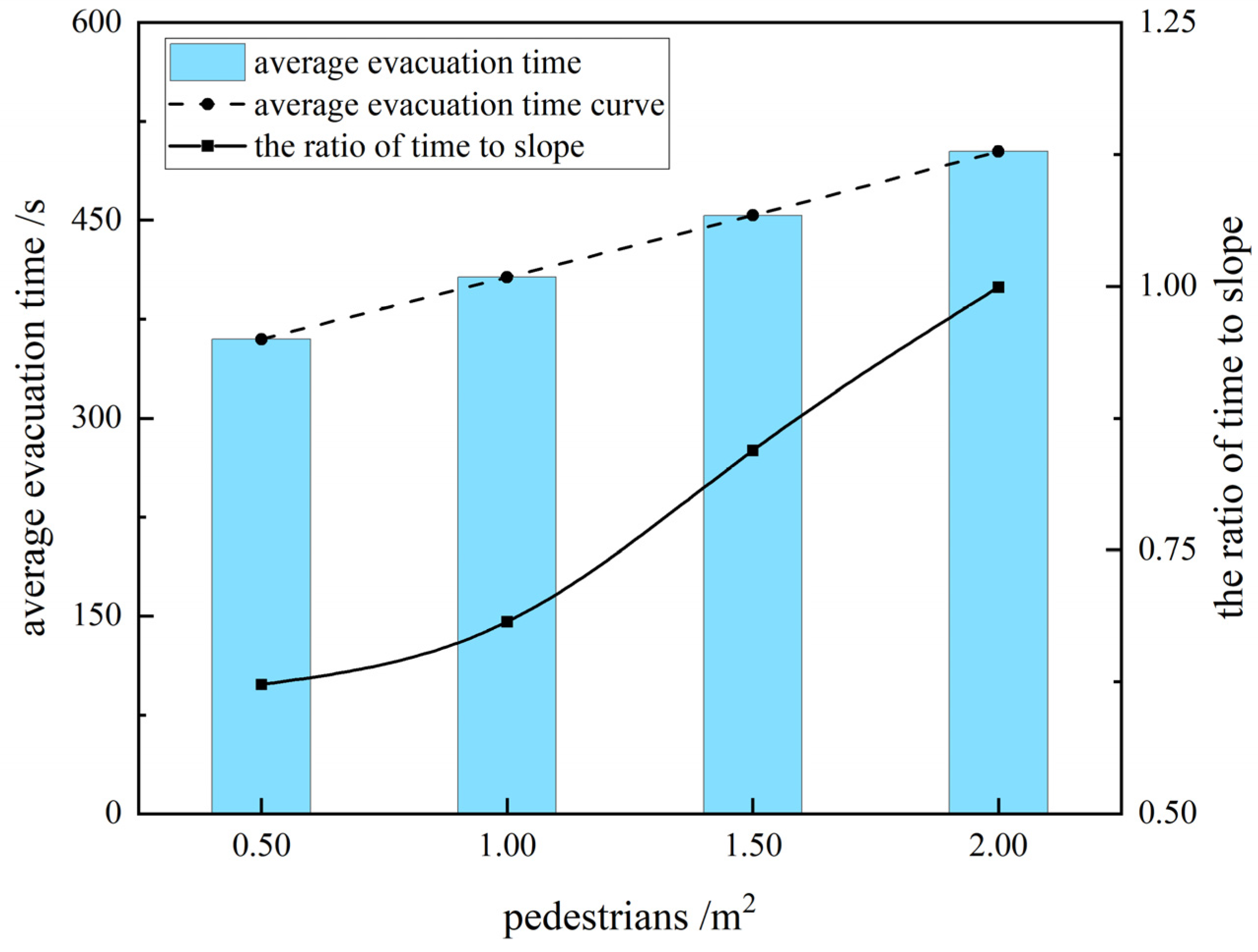
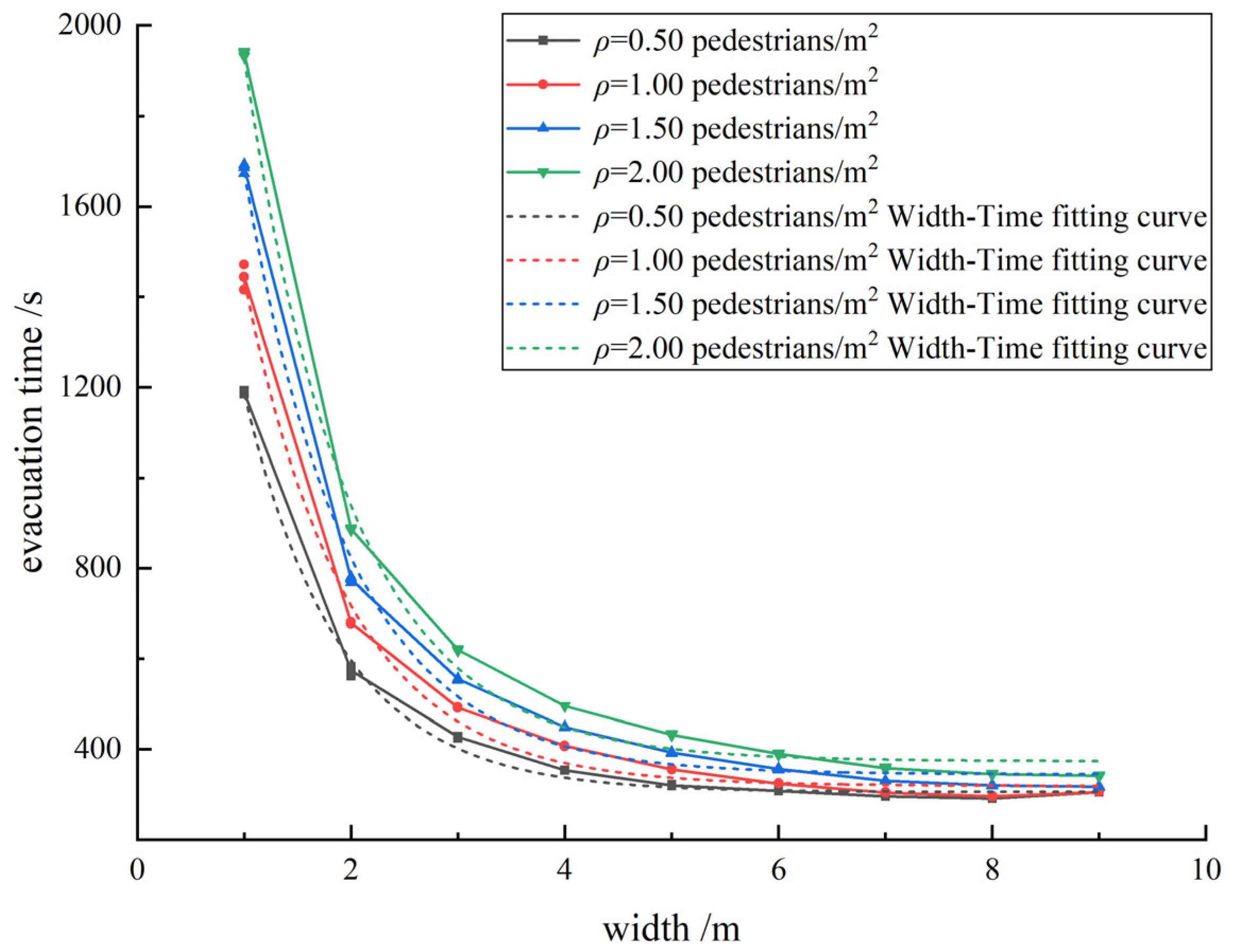
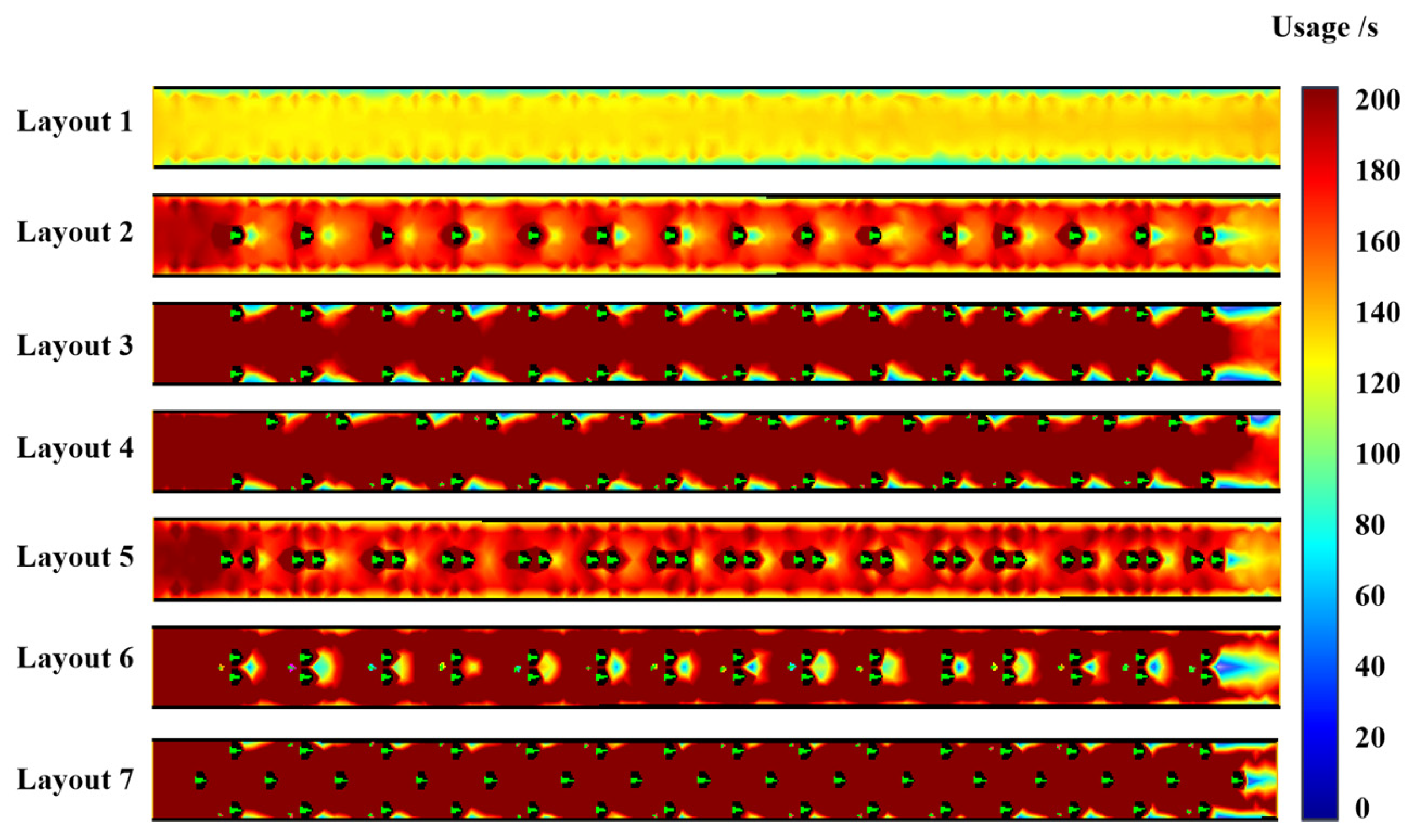

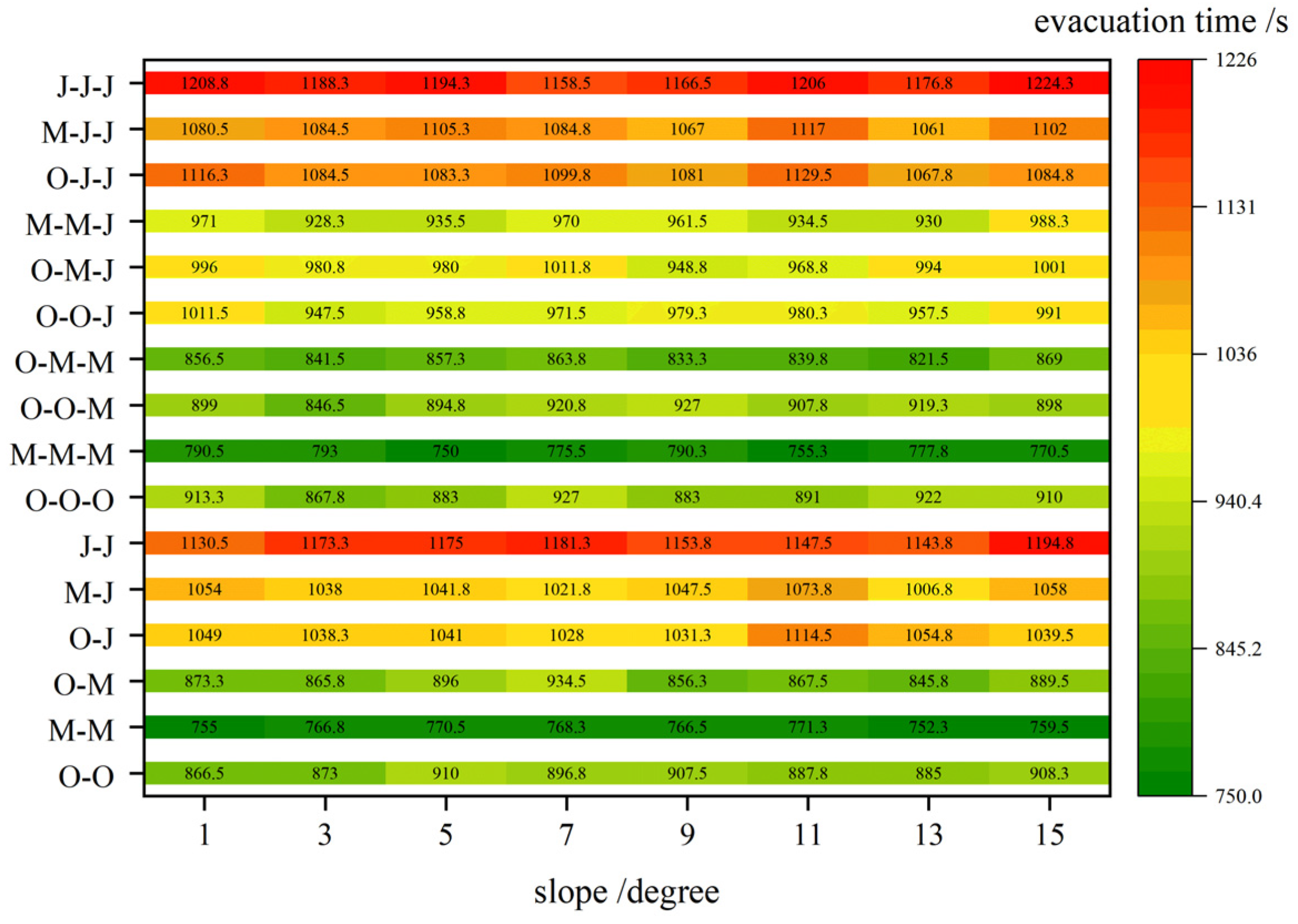

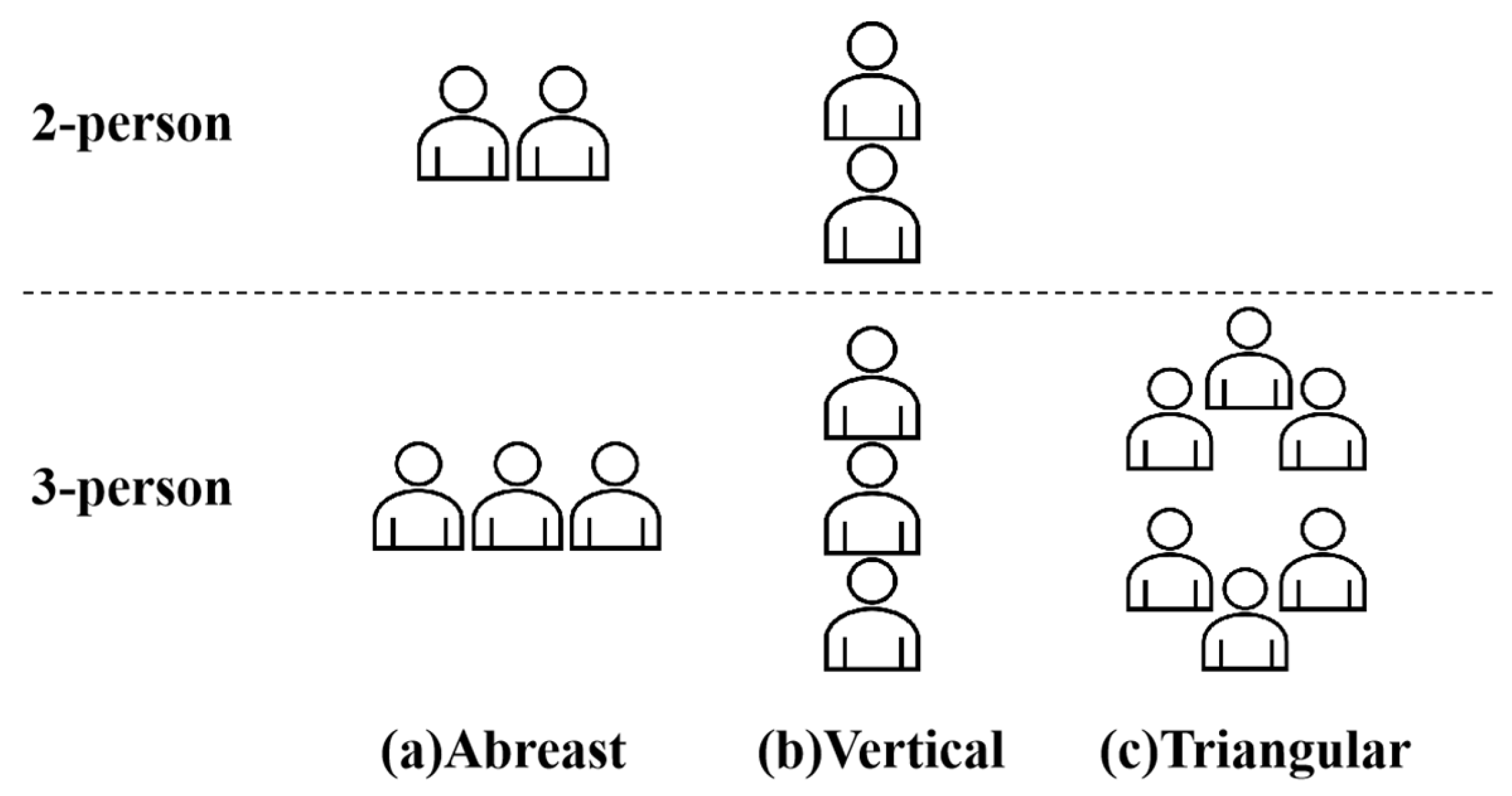
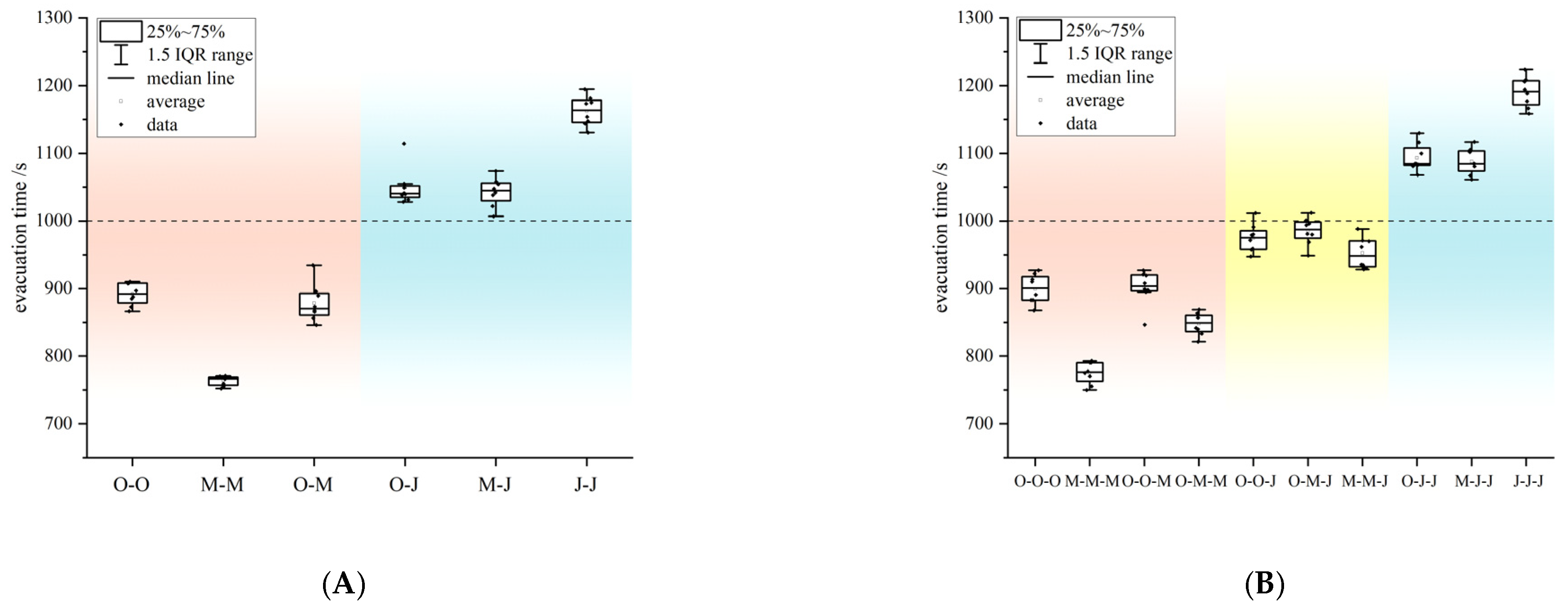

| Slope (Degrees) | Density (Pedestrians/m2) | (m/s) | Actual Speed: (m/s) | |||
|---|---|---|---|---|---|---|
| 0 | 0.5 | 1.4 | 1 | 0.9 | 1 | 1.26 |
| −4 | 1.0 | 1.4 | 1.18 | 0.9 | 0.91 | 1.17 |
| −4 | 1.5 | 1.4 | 1.28 | 0.8 | 0.77 | 0.78 |
| −10 | 1.0 | 1.4 | 0.75 | 0.9 | 0.91 | 0.74 |
| −10 | 1.5 | 1.4 | 0.85 | 0.8 | 0.83 | 0.56 |
| Categories | Age (Years) | Maximum Speed: v (m/s) | Shoulder Width (m) | Share (%) |
|---|---|---|---|---|
| Juvenile | 6 ≤ age ≤ 18 | 0.90 | 0.4000 | 20 |
| Middle-aged people | 18 < age ≤ 60 | 1.40 | 0.4558 | 70 |
| Older people | age > 60 | 1.00 | 0.4558 | 10 |
| Type of Mobility Impairment | Maximum Speed: v (m/s) | Shoulder Width (m) |
|---|---|---|
| People without disabilities | 1.40 | 0.4558 |
| Unassisted walking using a wheelchair | 0.69 | 0.6100 |
| Unassisted walking using a cane | 0.94 | 0.4558 |
| Visually impaired | 0.86 | 0.4558 |
| Hearing impaired | 1.25 | 0.4558 |
| Type of Mobility Impairment | Percentage with Disabilities (%) | |||||||||
|---|---|---|---|---|---|---|---|---|---|---|
| Unassisted walking using a wheelchair | 10 | 20 | 30 | 40 | 50 | 60 | 70 | 80 | 90 | 100 |
| Unassisted walking using a cane | 10 | 20 | 30 | 40 | 50 | 60 | 70 | 80 | 90 | 100 |
| Visually impaired | 10 | 20 | 30 | 40 | 50 | 60 | 70 | 80 | 90 | 100 |
| Hearing impaired | 10 | 20 | 30 | 40 | 50 | 60 | 70 | 80 | 90 | 100 |
| Group Size | Working Condition | Group Type | Working Condition | Group Type |
|---|---|---|---|---|
| Group of 2 | 1 | O-O | 2 | M-M |
| 3 | O-M | 4 | O-J | |
| 5 | M-J | 6 | J-J | |
| Group of 3 | 7 | O-O-O | 8 | M-M-M |
| 9 | O-O-M | 10 | O-M-M | |
| 11 | O-O-J | 12 | O-M-J | |
| 13 | M-M-J | 14 | O-J-J | |
| 15 | M-J-J | 16 | J-J-J |
| Fitted Equation | ||||
|---|---|---|---|---|
| Density | ||||
| y0 | 305.61306 ± 7.71701 | 319.06594 ± 13.5872 | 345.00357 ± 16.78607 | 373.99962 ± 18.79928 |
| A | 2655.19675 ± 168.95449 | 3127.81417 ± 249.12569 | 3702.67456 ± 303.17803 | 4261.36783 ± 328.76825 |
| R0 | −1.10557 ± 0.05901 | −1.02977 ± 0.07287 | −1.02344 ± 0.07483 | −1.00995 ± 0.07032 |
| R2 | 0.99735 | 0.99518 | 0.99484 | 0.99529 |
| Layout Number | Evacuation Time (s) | Number of Stranded People | |||||||||||||
|---|---|---|---|---|---|---|---|---|---|---|---|---|---|---|---|
| 1 | 2 | 3 | 4 | 5 | 6 | 7 | 1 | 2 | 3 | 4 | 5 | 6 | 7 | ||
| Density (pedestrians/m2) | 0.50 | 359 | 435 | 556 | 543 | 446 | 625 | 703 | 0 | 0 | 19 | 20 | 0 | 10 | 34 |
| 1.00 | 407 | 498 | 653 | 631 | 515 | 748 | 764 | 0 | 0 | 21 | 23 | 0 | 12 | 35 | |
| 1.50 | 454 | 567 | 763 | 701 | 584 | 858 | 874 | 0 | 0 | 22 | 25 | 0 | 14 | 37 | |
| 2.00 | 503 | 634 | 840 | 788 | 653 | 965 | 1142 | 0 | 0 | 25 | 29 | 0 | 17 | 40 | |
Disclaimer/Publisher’s Note: The statements, opinions and data contained in all publications are solely those of the individual author(s) and contributor(s) and not of MDPI and/or the editor(s). MDPI and/or the editor(s) disclaim responsibility for any injury to people or property resulting from any ideas, methods, instructions or products referred to in the content. |
© 2025 by the authors. Licensee MDPI, Basel, Switzerland. This article is an open access article distributed under the terms and conditions of the Creative Commons Attribution (CC BY) license (https://creativecommons.org/licenses/by/4.0/).
Share and Cite
Li, K.; Yao, T.; Lin, X.; Lin, X.; You, X. Analysis of the Efficiency of Slope Evacuation for Dense Crowds in Urban Street-Type Public Spaces. Appl. Sci. 2025, 15, 3568. https://doi.org/10.3390/app15073568
Li K, Yao T, Lin X, Lin X, You X. Analysis of the Efficiency of Slope Evacuation for Dense Crowds in Urban Street-Type Public Spaces. Applied Sciences. 2025; 15(7):3568. https://doi.org/10.3390/app15073568
Chicago/Turabian StyleLi, Kailing, Tiantian Yao, Xue Lin, Xiaoye Lin, and Xiaogang You. 2025. "Analysis of the Efficiency of Slope Evacuation for Dense Crowds in Urban Street-Type Public Spaces" Applied Sciences 15, no. 7: 3568. https://doi.org/10.3390/app15073568
APA StyleLi, K., Yao, T., Lin, X., Lin, X., & You, X. (2025). Analysis of the Efficiency of Slope Evacuation for Dense Crowds in Urban Street-Type Public Spaces. Applied Sciences, 15(7), 3568. https://doi.org/10.3390/app15073568





